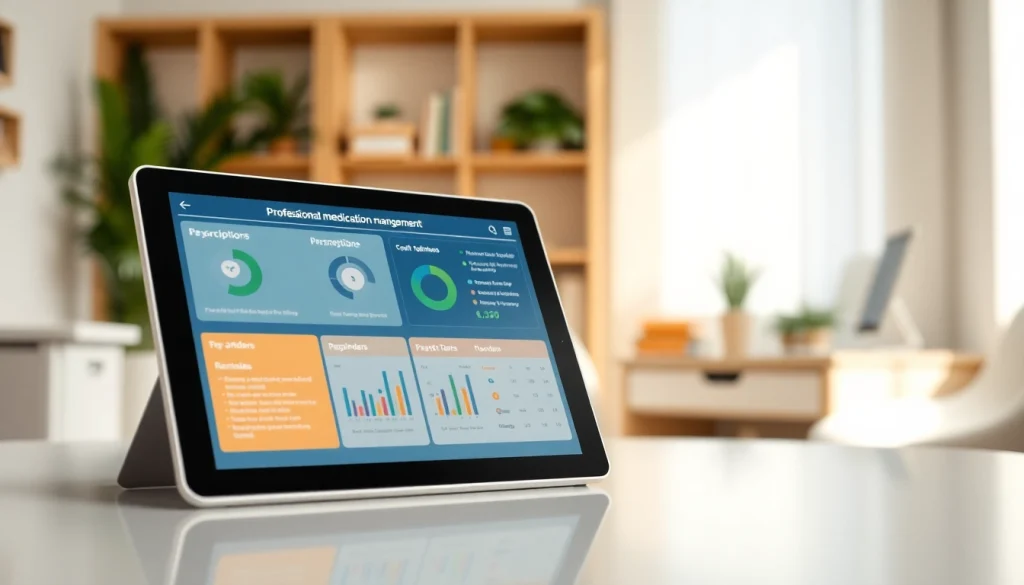
Understanding the Importance of Prescription Applications
As the healthcare landscape evolves, more individuals are turning towards technology for managing their health, particularly with medication. Prescription applications have become essential tools for patients, providing a means to manage prescriptions easily and efficiently. These applications not only streamline medication management but also enhance communication between healthcare providers and patients. By utilizing top rated prescription applications, users can gain a clearer insight into their medication schedules, dosage intricacies, and refill reminders, ultimately supporting better health outcomes.
Benefits of Top Rated Prescription Applications
The adoption of top rated prescription applications offers numerous advantages that can significantly improve the way individuals engage with their health. Some primary benefits include:
- Convenience: Users can access their prescriptions anytime and anywhere, ensuring that critical medication information is always at their fingertips.
- Time-saving: These applications simplify the refilling process by enabling quick reorders or direct communication with pharmacies.
- Medication Reminders: With automatic reminders, patients are less likely to miss doses or forget to refill their medications.
- Access to Information: Patients can easily access detailed information about their medications, including potential side effects and interactions.
- Cost Management: Some applications also provide pricing comparisons and discount options, aiding patients in making informed decisions regarding their medications.
How These Applications Enhance Medication Adherence
Medication adherence is crucial for effective treatment outcomes, and top rated prescription applications play a significant role in promoting compliance among users. With features such as personalized reminders, medication tracking, and feedback loops, these applications empower users to take charge of their health. For example, patients using applications that provide adherence metrics can see their progress over time, motivating them to stay consistent in their medication routines. Additionally, these applications often incorporate educational features, helping users understand the importance of their prescribed regimens and how they impact their health.
User Experiences with Prescription Applications
User experiences often dictate the success of prescription applications. Surveys and user feedback indicate that individuals appreciate applications offering a seamless interface, clear navigation, and supportive customer service. Positive user experiences often hinge on ease of use and personalization; applications that provide customization options for reminders or tailored notifications see higher levels of user satisfaction. Furthermore, the integration of customer support within the applications is a crucial factor, addressing issues that may arise during usage and fostering trust and reliability.
Features to Look for in Top Rated Prescription Applications
Key Functionalities for Effective Usage
Not all prescription applications are created equal, and it is essential to recognize the features that enhance their usability and effectiveness. Important functionalities include:
- Prescription Management: The ability to add, edit, and delete prescriptions easily.
- Reminder Notifications: Customizable alerts for refills and medication timings ensure adherence.
- Drug Interaction Checker: Alerts for potential interactions between prescribed medications.
- CVS Pharmacy Integration: Some applications allow direct communication with pharmacies for streamlined refills.
- Patient-Provider Communication: Enabling direct messages or consultations with healthcare providers enhances the user experience and increases engagement.
Security and Privacy Considerations
As prescription applications manage sensitive patient information, robust security and privacy measures are critical. Users should select applications that utilize strong encryption methods, comply with HIPAA regulations, and provide clear privacy policies outlining how personal information is collected, used, and shared. Additionally, two-factor authentication and secure login options can bolster security, ensuring that patient data remains protected against unauthorized access.
User-Friendly Interfaces and Accessibility
User interface and accessibility are pivotal for ensuring a positive user experience. Users should look for applications that feature intuitive design, large fonts, and easy-to-read instructions. Convenient accessibility features, such as voice commands or support for visually impaired users, can further enhance usability. Applications that provide tutorials or guided walkthroughs for first-time users can also foster a supportive onboarding experience.
Comparative Analysis of Popular Prescription Applications
Criteria for Evaluating Top Rated Prescription Applications
The evaluation of prescription applications should focus on multiple criteria to ensure users select options that best meet their health needs. Key factors to consider include:
- Feature Set: The variety and depth of functionalities provided by the application.
- User Ratings and Reviews: Analytics from existing users offer insights into the application’s performance and reliability.
- Customer Support: Availability and quality of customer support services.
- Security Measures: Evaluation of data protection protocols and compliance standards.
- Integration Capabilities: The ability to connect with other health tools or systems for a comprehensive health management experience.
Strengths and Weaknesses of Leading Applications
To assist users in making informed choices, it’s critical to examine the strengths and weaknesses of various top rated prescription applications. For instance, some applications excel in user interface design, making navigation straightforward and enjoyable. Others may offer comprehensive databases for drug interaction checks, equipping users with vital information for safe medication usage. Conversely, some applications may lag in customer support response times or provide limited functionalities, which can detract from overall user experience. Understanding these strengths and weaknesses is essential for selecting a tool that aligns with individual health management goals.
Case Studies of Successful Implementation
Real-world applications of these tools highlight their effectiveness in managing patient care. For example, a healthcare practice that incorporated a prescription application reported improved medication adherence rates among patients. By leveraging the app’s reminder features and direct communication capabilities, the practice enabled patients to engage more actively in their health management. Within months, adherence rates improved significantly, leading to heightened overall patient satisfaction and health outcomes.
Maximizing the Use of Prescription Applications for Health Management
Tips for Setting Up and Customizing Your Application
Getting the most out of a prescription application begins with proper setup and customization. Users should complete their profiles with detailed medical histories and current medications to allow the application to tailor its features to their needs. It’s advisable to explore all available functionalities, such as setting unique reminders for different medications or exploring educational resources related to prescribed treatments. Regularly updating preferences as health conditions change can also enhance the application’s relevance and usability.
Integrating Prescription Applications with Other Health Tools
Prescription applications can offer even greater value when integrated with other health tools. For example, users might benefit from linking their prescription applications with health tracking devices or wellness apps to monitor overall health indicators such as blood pressure or glucose levels. This holistic approach can empower users to take informed actions based on comprehensive health data, thereby improving health outcomes.
Monitoring Progress and Making Adjustments
Monitoring progress is vital for evaluating the effectiveness of any health management tool. Users should regularly review their medication adherence statistics provided by the application and adjust their routines as necessary. Utilizing the feedback features where users can report how they feel on specific medications or note any side effects can also provide critical data for both users and their healthcare providers, leading to more informed treatment decisions.
Future Trends in Prescription Applications
Emerging Technologies Enhancing Medication Management
The future of prescription applications is bright, with technological advancements continuously enhancing their capabilities. Emerging technologies such as artificial intelligence and machine learning have shown potential in personalizing medication management further. These technologies can analyze individual user data patterns to provide smarter reminders, suggest alternatives based on behavior patterns, and predict potential adherence challenges. With advancements in telehealth, users may also see integrations that allow virtual consultations directly through the application.
Potential Impact of Regulatory Change on Application Development
As the regulatory environment evolves, so do the requirements for prescription applications. Compliance with healthcare regulations is paramount for protecting patient data and ensuring user trust. As new policies emerge, application developers must adapt quickly to remain compliant, which could influence how features are designed, data is managed, and user interactions are facilitated. Staying abreast of regulatory changes will be essential for future-proofing these applications.
Anticipated User Needs and Market Response
As user expectations evolve, the prescription application market must respond proactively to meet these needs. Anticipated requires includes enhanced personalization, deeper integration with other health tools, and the availability of robust educational resources within the applications. User feedback mechanisms will also become crucial as applications evolve; understanding user needs allows developers to adjust features or services accordingly. Ultimately, a focus on user-centric design will dictate how successful these applications will be in generating long-term user engagement and satisfaction.






